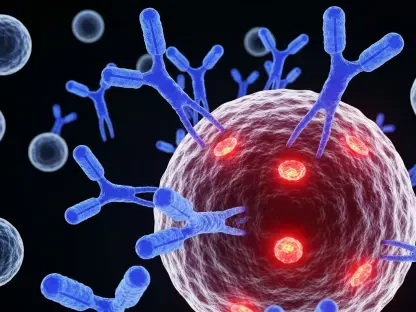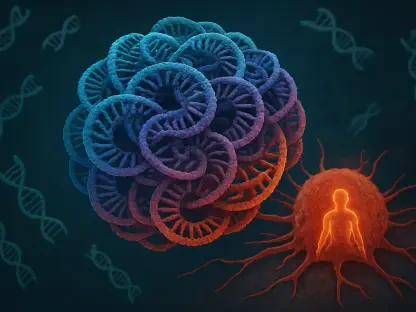A consortium of 38 leading scientists spanning various disciplines has issued a stark warning regarding the potential creation of “mirror bacteria” – synthetic organisms with reversed molecular structures. This concept, while seemingly out of a science fiction plot, poses significant risks that could lead to catastrophic consequences. The development of mirror bacteria, driven by curiosity and the exploration of life’s origins, presents an exciting scientific challenge. However, it comes with a Pandora’s box of possible dangers that could spiral beyond human control. The intricate structures of these organisms could lead to unpredictable outcomes that have extensive ramifications for ecosystems and human health, demanding immediate attention and stringent regulatory scrutiny.
Understanding Mirror Bacteria
Molecular Chirality and Biological Systems
The primary theme of the article is the inherent danger posed by the potential development of mirror bacteria. This concept is grounded in molecular chirality or “handedness,” where biological systems traditionally follow a specific uniformity. DNA and RNA in natural bacteria are composed of right-handed molecules, while proteins comprise left-handed amino acids. Mirror bacteria would reverse this natural order, creating organisms with left-handed DNA/RNA and right-handed proteins. This shift could result in organisms that are unrecognizable to natural immune systems, potentially making them immune to antibiotics and other natural biological defenses. The creation of these unnatural organisms could inadvertently lead to a host of new diseases that our current medical infrastructure may be ill-equipped to handle.
Chirality has always been a fundamental concept in the study of life sciences, dictating not only the structure but also the function of biological molecules. The push to develop mirror bacteria stems from an intellectual curiosity about how life might appear and function at a molecular level if its chirality were reversed. Scientists hope that studying such mirror systems could provide profound insights into the nature of chirality itself, possibly shedding light on the origins and evolution of life. Yet, the potential benefits are overshadowed by the profound risks that come with tampering with molecular chirality. Mirror bacteria’s reversed structures could lead them to be fundamentally incompatible with all known biological systems, turning them into highly virulent organisms that conventional medical treatments cannot detect or neutralize.
Resistance to Existing Controls
A significant point of discussion is the potential resistance of mirror bacteria to existing controls. Unlike natural bacteria that are vulnerable to bacteriophages, antibiotics, and predators, mirror bacteria might resist all these measures due to their reversed molecular structure. This resistance poses a significant ecological and health risk, as these synthetic organisms could evade detection and uncontrollably spread across ecosystems, potentially causing lethal infections in various species, including humans. The idea that an entirely new class of organisms might emerge, untouchable by current biological control mechanisms, is alarming. It emphasizes the need for robust protocols and preventive measures in synthetic biology.
Given these potential risks, there is an urgent call for stringent biosecurity measures. Scientists are advocating for the prioritization of research into the controls and limits of such bacteria, long before any experimental creation or release is attempted. These discussions underscore the necessity for international collaboration to establish universal guidelines and regulatory frameworks designed to prevent mirror bacteria from becoming an unprecedented biological hazard. The worst-case scenarios include the uncontrollable proliferation of mirror bacteria across diverse ecosystems, resulting in the possible decimation of native species and the destabilization of ecological balances that have existed for millennia.
Scientific Curiosity and Potential Advancements
Revolutionary Advancements in Medicine and Biotechnology
The authors also emphasize the scientific curiosity driving this research, underscored by the potential for revolutionary advancements in medicine, biotechnology, and extraterrestrial life exploration. The creation of mirror bacteria could lead to new therapeutic compounds and a deeper understanding of life’s origins. However, they caution that the creation of such entities could have unforeseen and uncontrollable consequences. While the allure of pioneering breakthroughs continues to attract significant academic and financial interest, the fundamental unpredictability poses a dilemma between scientific exploration and ethical responsibility. This research stands on the precipice of groundbreaking discoveries and nightmarish scenarios.
The potential for medicinal breakthroughs through mirror bacteria is particularly tantalizing. Scientists speculate that manipulating the chirality of molecular structures could lead to the development of novel drugs with enhanced efficacy and fewer side effects. Furthermore, studying these organisms could reveal unique biochemical pathways that may inspire new biotechnological applications, from advanced materials to innovative environmental solutions. However, to achieve these potential benefits without tipping the scales towards disaster, it is imperative to establish rigorous containment and risk assessment protocols. The intersection of vast medical potential and significant biohazards necessitates a careful, reasoned approach to ensure safety is not compromised in the pursuit of knowledge.
Ethical and Practical Boundaries
The authors argue that the creation of mirror bacteria crosses an ethical and practical boundary in biology. While scientific curiosity and the pursuit of knowledge are vital, the potential dangers associated with mirror bacteria necessitate careful consideration. They suggest halting all research aimed at creating mirror bacteria until their safety can be fully understood. Recommendations include avoiding funding for such projects and establishing policies to evaluate risks and halt dangerous experiments. Creating organisms that have no natural checks and balances within our ecosystems poses ethical questions about the responsibility and foresight required in the scientific process.
The discussion around mirror bacteria also touches on broader ethical considerations in synthetic biology. Researchers must grapple with the question of whether it is morally acceptable to create life forms with potentially disastrous implications for existing ecosystems and human health. Issues of consent, environmental stewardship, and the long-term impact on planet Earth are at the forefront of these debates. Pay close attention to evaluating not only the immediate scientific gains but also the enduring consequences that could arise from such profound biological manipulations. As with many groundbreaking technologies, the race for advancement must be tempered by a conscientious appraisal of the broader ethical landscape, ensuring that progress does not come at the expense of ecological and biological integrity.
Risks and Potential Consequences
Immune System Evasion and Ecosystem Disruption
The primary risk of mirror bacteria is their potential to evade natural defenses and disrupt ecosystems. The immune systems of humans, animals, and plants rely on recognizing specific molecular shapes to detect and destroy pathogens. Mirror bacteria, with their reversed molecular structures, would likely go unnoticed by these immune systems, leading to severe and potentially lethal infections. The potential destruction brought by these organisms could range from localized outbreaks to widespread biological havoc, fundamentally altering the composition of diverse ecosystems. As modern medicine embarks on new frontiers, it must also vigilantly guard against unprecedented biological threats.
Ecosystem disruption could cascade through the food chain, affecting every level from microorganisms to apex predators. If mirror bacteria contaminate a water source or agricultural fields, they could lead to mass die-offs of plants and animals, triggering a domino effect that compromises food security and human livelihoods. The difficulty in containing such outbreaks due to their resistance to conventional measures would exacerbate the crisis. The potential for widespread environmental damage necessitates that the research community engages in thorough preparatory risk analyses before proceeding. Rigorous environmental assessment and comprehensive preparedness planning should be instituted to mitigate the potential for catastrophic outcomes if mirror bacteria are inadvertently or maliciously released into natural systems.
Unpredictable Behavior and Evolution
Furthermore, the scientists warn that mirror bacteria could behave unpredictably, mutating and evolving over time. Their resistance to natural predators and existing controls makes them exceptionally dangerous. There is a possibility that mirror bacteria, if created, could spread uncontrollably and act invasively across many ecosystems, causing widespread harm to plants, wildlife, agriculture, and human health. Addressing these issues requires anticipating possible evolutionary pathways that these organisms might take, potentially resulting in more virulent and resilient strains. The unpredictable evolution of such entities adds layers of complexity to risk management and regulatory oversight.
The inherent unpredictability in the behavior of novel synthetic organisms underscores the importance of a robust, multidisciplinary approach to research and risk assessment. Evolutionary biology, ecology, and systems biology must converge to create predictive models that can identify potential threats before they manifest. Proactive, anticipatory governance must be established at both national and international levels to ensure rapid response mechanisms are in place. Additionally, public awareness and engagement are crucial for fostering a collective understanding of the risks and gaining societal consensus on acceptable boundaries for such pioneering research endeavors. The possibility of unintended and uncontrolled consequences demands a clear, actionable framework for managing and mitigating risks associated with mirror bacteria.
Historical Context and Ethical Dilemma
Parallels with Previous Scientific Breakthroughs
The article places the discussion within a broader historical context, drawing parallels with previous scientific breakthroughs like nuclear energy and genetic engineering, which while groundbreaking, have led to unintended consequences. The creation of mirror bacteria represents a scientific frontier that could offer revolutionary advancements but also carries existential risks. Historical precedents underscore both the transformative potential and the inherent dangers of major scientific advances, highlighting the dual-edged nature of innovation. The parallels drawn with past breakthroughs serve as cautionary tales, urging present-day scientists to tread carefully in exploring these uncharted territories.
Examining the historical impact of nuclear energy reveals the dual aspects of scientific progress: the capacity for monumental advances paired with the need for stringent safeguards. The same holds true for genetic engineering, which has given rise to remarkable medical therapies and advancements in agriculture but also engendered deep ethical debates around genetically modified organisms. The lessons derived from these histories underline the critical importance of establishing robust oversight mechanisms before moving forward with potentially disruptive technologies. By learning from the past, the scientific community can better anticipate and mitigate the risks associated with mirror bacteria, ensuring that innovation does not imperil societal or ecological well-being.
Balancing Innovation and Oversight
The ethical dilemma revolves around whether the pursuit of understanding life’s origins and creating new therapeutic compounds is worth the potential threat to ecosystems and public health. History has shown that innovation requires careful oversight to prevent unintended consequences. The scientists argue for a combination of caution and deeper research to establish policies for evaluating risks and promoting transparency in synthetic biology. Balancing the thirst for knowledge with a commitment to safety and ethical responsibility is essential in steering the course of future scientific endeavors.
Effective oversight involves more than just regulatory compliance; it requires an ongoing dialogue among scientists, ethicists, policymakers, and the public to ensure that the direction of research aligns with broader societal values. Establishing formal frameworks for ethical review and risk assessment can help navigate the challenges posed by revolutionary technologies like mirror bacteria. This proactive approach facilitates informed decision-making, enabling the scientific community to advance responsibly while safeguarding public health and environmental integrity. By fostering a culture of transparency and accountability in synthetic biology, society can reap the benefits of innovation while minimizing the potential for harm.
Recommendations for Future Research
Cautious Approach and Policy Development
The main findings of the article underscore the significant risks associated with the potential creation of mirror bacteria. While the concept remains theoretical, the scientists’ warnings highlight the need for cautious and responsible research practices. The creation of such organisms could lead to immune system failures, ecosystem disruptions, and resistance to existing controls, posing unparalleled dangers to human health and the environment. The urgency in addressing these issues cannot be overstated, as the theoretical risks, though distant, could rapidly evolve into tangible challenges that affect global ecosystems and public health.
To mitigate these risks, proposed recommendations stress halting all research on mirror bacteria until their safety can be thoroughly evaluated. Creating a predictable and safe framework for studying mirror bacteria demands cross-disciplinary collaboration and comprehensive risk assessments. Securing funding and institutional support for research into safeguard mechanisms must take precedence over the creation of the organisms themselves. Establishing stringent containment protocols and emergency response plans will be pivotal in preventing potential catastrophic outcomes. Policymakers are tasked with setting up a regulatory environment that preempts and prohibits any research that does not adequately address these safety concerns.
Promoting Transparency and Responsible Research
A group of 38 prominent scientists from various fields has sounded an urgent alarm about the potential creation of “mirror bacteria”—synthetic organisms designed with reversed molecular structures. This idea, which might seem like something out of science fiction, holds significant risks that could result in disastrous outcomes. While the concept of mirror bacteria represents an intriguing scientific endeavor aimed at uncovering the mysteries of life’s origins, it also opens a Pandora’s box of potential dangers that could spiral out of human control. The complex nature of these organisms means they could produce unpredictable results, leading to broad implications for ecosystems and human health. This pressing issue necessitates immediate attention and stringent regulatory measures to mitigate potential hazards. These scientists warn that the unforeseen consequences of such organisms could be far-reaching, emphasizing the critical need for careful oversight and responsible research practices.









